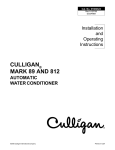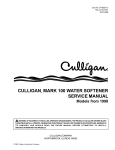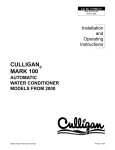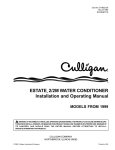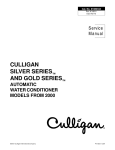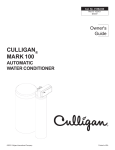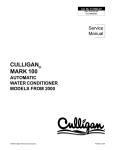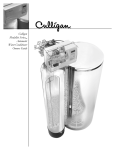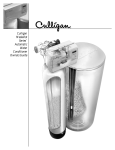Download Culligan Automatic Water Softeners Operating instructions
Transcript
Cat. No. 01-8819-48 Revised 1/96 CULLIGAN MARK 10 AUTOMATIC WATER CONDITIONER Installation/Operating Instructions ® Models from 1995 WARNING: IF INCORRECTLY INSTALLED, OPERATED OR MAINTAINED, THIS PRODUCT CAN CAUSE SEVERE INJURY. THOSE WHO INSTALL, OPERATE, OR MAINTAIN THIS PRODUCT SHOULD BE TRAINED IN ITS PROPER USE, WARNED OF ITS DANGERS, AND SHOULD READ THE ENTIRE MANUAL BEFORE ATTEMPTING TO INSTALL, OPERATE OR MAINTAIN THIS PRODUCT. CULLIGAN COMPANY NORTHBROOK, ILLINOIS 60062 ©1996 Culligan International Company Printed in USA Attention Culligan Customer: The installation, service and maintenance of this equipment should be rendered by a qualified and trained service technician. Your local independently operated Culligan dealer employs trained service and maintenance personnel who are experienced in the installation, function and repair of Culligan equipment. This publication is written specifically for these individuals and is intended for their use. We encourage Culligan users to learn about Culligan products, but we believe that product knowledge is best obtained by consulting with your Culligan dealer. Untrained individuals who use this manual assume the risk of any resulting property damage or personal injury. WARNING — Prior to servicing equipment, disconnect power supply to prevent electrical shock. IF THIS EQUIPMENT IS TO BE USED IN THE TREATMENT OF DRINKING WATER, THE WATER MUST BE MICROBIOLOGICALLY SAFE. CULLIGAN MARK 10 AUTOMATIC WATER CONDITIONERS Installation/Operating Instructions ® Models from 1995 Table of Contents Specifications ........................................................... 2 Preparation ............................................................... 3 Installation ................................................................ 5 Settings .................................................................... 9 Start-Up Procedure ................................................ 14 Sanitizing Procedure .............................................. 15 Specifications Culligan® Mark 10 Automatic Water Conditioners with Auto Clock or Soft-Minder® Meter Control Valve Overall Conditioner Height Media Tank Dimensions (Dia x Ht) Salt Storage Tank Dimensions Exchange Media, Type and Quantity Underbedding Type and Quantity Exchange Capacity @ Salt Dosage Per Recharge1 Freeboard to Media2 Salt Storage Capacity Rated Service Flow @ Pressure Drop Total Hardness, Maximum Total Iron, Maximum Hardness to Iron Ratio, Minimum4 Operating Pressure Operating Temperature Electrical Requirements Electrical Power Consumption, Min/Max Drain Flow, Maximum5 Recharge Time, Average6 Recharge Water Consumption, Average6 1 2 3 4 5 6 9" Model 5-cycle, Reinforced Thermoplastic 44 in (1118 mm) 9 x 38 in (229 x 965 mm) 16 x 43 in (406 x 1092 m) Cullex® Media, 0.7 cu ft (20 liters) None 15,500 grains (1 000 grams) @ 4.0 lb (1.8 kg) 20,300 grains (1 315 grams) @ 8.0 lb (3.6 kg) 22,500 grains (1 450 grams) @ 12.0 lb (5.4 kg) 14.75-16.75 in (374.7-425.5 mm) 250 lb (114 kg) 7.4 gpm @ 15 psi (29.6 lpm @ 100 kPa) 75 gpg (1 300 mg/l) 5 ppm (5 mg/l) 8 gpg Hardness to 1 ppm Iron (140 mg/l Hardness to 1 mg/l Iron) 20 - 125 psi (140 - 860 kPa) 33 - 120°F (1 - 50°C) 120 Volts AC, 60 Hertz 3 Watts/25 Watts 12" Model 5-Cycle, Reinforced Thermoplastic 44 in (1118 mm) 12 x 38 in (305 x 965 mm) 16 x 43 in (457 x 1092 mm) Cullex Resin, 1.4 cu ft (40 liters) None 28,800 grains (1 866 grams) @ 8.0 lb (3.6 kg) 37,500 grains (2 430 grams) @ 12.0 lb (5.4 kg) 43,600 grains (2 825 grams) @ 16.0 lb (7.2 kg) 14.5-16.5 in (368.3-419.1 mm) 375 lb (170 kg) 7.4 gpm @ 15 psi (31 lpm @ 100 kPa) 100 gpg (1 700 mg/l) 5 ppm (5 mg/l) 8 gpg Hardness to 1 ppm Iron (140 mg/l Hardness to 1 mg/l Iron) 20 - 125 psi (140 - 860 kPa) 33 - 120°F (1 - 50°C) 120 Volts AC, 60 Hertz 3 Watts/25 Watts 3.4 gpm (13 lpm) 70 min 64 gal (242 liters) 3.4 gpm (13 lpm) 70 min 110 gal (416 liters) Capacities and corresponding salt dosages pertain to low hardness waters. Capacities given are per recharge. Measured from top of media to top of inlet fitting (backwashed and drained). Measured from top of underbedding to top of inlet fitting. Hardness to iron ratio does not apply and total hardness and iron specifications change as follows when Sofner-Gard™ Accessory is used. Backwash at 120 psi (830 kPa). 10 minute backwash. 2 / CULLIGAN MARK 10 AUTOMATIC WATER CONDITIONER Preparation COMPONENT DESCRIPTION The water conditioner is shipped from the factory in one carton. Remove all components and inspect them before starting installation. Control Valve Assembly - Includes the 5- cycle regeneration control valve and electronic timer assembly. A small parts package contains installation hardware and consumer literature, including an Owner’s Guide and warranty policy. Media Tank - Contains the Tripl-Hull™ media tank complete with Cullex® ion exchange resin, underbedding and outlet manifold. Salt Storage Tank Assembly - Includes salt storage container with support plate and Dubl-Safe™ brine refill valve and chamber. • Threading tools, pipe wrenches and thread sealer for threaded connections • Saw, solvent and cement for plastic pipe connections Materials • Brine line, 5/16" (PN 00-3031-28 or equivalent) • Drain line, 1/2" (PN 00-3030-82, gray, semi-flexible; or PN 00-3319-46, black, semi-rigid; or equivalent) • Thread sealing tape • Pressure reducing valve (if pressure exceeds 125 psi [860 kPa], PN 00-4009-00 or equivalent) • Pipe and fittings suited to the type of installation • Water softener salt (rock, solar or pellet salt formulated specifically for water softeners) BYPASS VALVES A bypass valve is included with the control valve assembly. TOOLS AND MATERIALS APPLICATION The following tools and supplies will be needed, depending on installation method. Observe all applicable codes. All Installations • • • • Safety goggles Phillips screwdrivers, small and medium tip Gauge assembly (PN 00-3044-50 or equivalent) Silicone lubricant (PN 00-4715-07 or equivalent) - DO NOT USE PETROLEUM-BASED LUBRICANTS. • A bucket, preferably light-colored • Towels Water quality - Verify that raw water hardness and iron are within limits. Note the hardness for setting the salt dosage and recharge frequency. Pressure - If pressure exceeds 125 psi (860 kPa), install a pressure reducing valve (see materials checklist). On private water systems, make sure the minimum pressure (the pressure at which the pump starts) is greater than 20 psi (140 kPa). Adjust the pressure switch if necessary. CAUTION: The use of a pressure reducing valve may limit the flow of water in the household. Special Tools • Torch, solder and flux for sweat copper connections Temperature - Do not install the unit where it might freeze, or next to a water heater or furnace or in direct sunlight. PREPARATION / 3 LOCATION NOTICE: Most codes require an anti-siphon device or airgap. Space requirements - Allow 6-12 inches (15-30 cm) behind the unit for plumbing and drain lines and 4 feet (1.3 meters) above for service access and filling the salt container. Electrical facilities - A 6-foot grounded cord is provided. The customer should provide a 3-prong grounded receptacle, preferably one not controlled by a switch that can be turned off accidentally. Observe local electrical codes. Floor surface - Choose an area with solid, level floor free of bumps or irregularities. Bumps, cracks, stones and other irregularities can cause the salt storage tank bottom to crack when filled with salt and water. WARNING! ELECTRICAL SHOCK HAZARD! DO NOT REMOVE THE GROUNDING PRONG! IF THE RECEPTACLE IS DESIGNED ONLY FOR 2-PRONG PLUGS, OBTAIN A 3-PRONG ADAPTER AND GROUND IT SECURELY TO THE RECEPTACLE. DO NOT USE EXTENSION CORDS. Drain facilities - Choose a nearby drain that can handle the rated drain flow (floor drain, sink or stand pipe). Refer to the Drain Line Chart, Table 1 (page ---), for maximum drain line length. 4 / CULLIGAN® MARK 10 AUTOMATIC WATER CONDITIONER Installation PLACEMENT BRINE CHAMBER ASSEMBLY Refer to Fig. 1 • Remove the nut and screw from the brine chamber housing. • Set the media tank on a solid, level surface near water, drain and electrical facilities. Place the outlet (black coupling) of the tank on the left. • Locate the hole in the recess of the brine tank. Place the screw through this hole. • Set the brine system on a flat, smooth, solid surface as near the media tank as possible. • Line up the hole in the brine chamber with the screw. Place the brine chamber onto the screw and secure with the nut. FIG. 1 INSTALLATION /5 • Place brine valve into the chamber. The top of the valve should rest within the groove of the brine chamber. CAUTION: Close the inlet supply line and relieve system pressure before cutting into the plumbing! Flooding could result! MOUNT THE CONTROL VALVE See Fig. 2. • Remove and discard the protective covers on the tank couplings. CAUTION: When making sweat connections, remove all plastic and rubber components which contact brass or copper. Damage to these components may result otherwise. BYPASS VALVE INSTALLATION • Position the light colored tank coupling to the right. This is the inlet side of the tank. WARNING: FAILURE TO PROPERLY POSITION TANK WILL RESULT IN LOSS OF MEDIA. The bypass valve connects directly to the backplate of the valve with a pair of screws (Fig. 3). Use a long standard screw driver to facilitate installation. Lubricate all o-rings with silicon lubricant. • Lubricate the o-rings on the tank couplings with silicon lubricant. BYPASS VALVE INSTALLATION (SOFT-MINDER® METER ONLY): • Place the control on the tank couplings and press down firmly. The Soft-Minder meter is placed between the bypass valve and the control (Fig. 4). Make sure the meter is on the outlet • Install the u-clamps on both sides of the control and secure with the screws. PLUMBING CONNECTIONS Two methods of connecting the water softener to the plumbing system are available. Shipped with each softener is a Culligan ® Cul-Flo-Valv ® bypass valve, either PN 00-3314-42 or 00-3314-46. If local conditions warrant, you may use the sweat adaptor kits, PN 00-3314-44 or 00-3314-45. NOTICE: The Soft-Minder® meter cannot be used with the sweat adaptors. FIG. 3 FIG. 2 6 / CULLIGAN® MARK 10 AUTOMATIC WATER CONDITIONER port of the control. A pair of elongated bolts are packaged with the meter to hold the bypass valve to the back plate of the control. Lubricate all o-rings with silicon lubricant. drain line length and height limitations, and to Fig. 6. SWEAT ADAPTOR INSTALLATION • Route a length of 1/2" drain line from the drain elbow to the drain. The seat adaptors use a snap ring to hold them to the backplate of the control valve. The back plate will need to be removed from the valve for this connection. A pair of snap ring pliers, PN 00-5916-09, are needed for this connection. CONNECT THE BRINE LINE • Remove 1/2" pipe clamp from end of drain elbow. • Fasten the drain line to the elbow with the clamp. • Secure the drain line to the drain to prevent its movement during regeneration. A loop in the end of the tube will keep it filled with water and will reduce splashing at the beginning of each regeneration. Refer to Fig. 5. • Measure a length of brine line sufficient to reach from the brine tank to the brine fitting and then add four feet (1.3 meters). Cut both ends squarely and cleanly. NOTICE: Observe all plumbing codes. most codes require an anti-siphon device or air gap at the discharge point! FILL THE SALT STORAGE CONTAINER • Remove the brine valve from the brine tank and remove the white nut and insert. Return float rod to its original position. Fill the salt storage container with water until the level reaches about 1 inch above the salt support plate. Pour salt into the container. Fill to within a few inches of the top. • Slip the white nut over one end of the tubing and press the plastic insert into the end of the tubing. Connect to the brine valve and tighten nut. SOFT-MINDER® METER CONNECTIONS • Remove white nut and insert from the brine elbow assembly. • Remove the timer case by grasping the front cover and pulling outward. • Slip the white nut over one end of the tubing and press the plastic insert into the end of the tubing. Connect to the brine connection on the valve and tighten nut. • Remove the screw from the protective cover and remove cover. To connect meter leads, proceed as follows: DRAIN LINE CONNECTION Refer to Table 1, page 11, under the applicable tank size for CAUTION: Do not allow the timer case to hang from the wires. Damage to the wires and/or terminals may result. FIG. 4 FIG. 5 INSTALLATION /7 • Locate the 1/2" hole in the lower right hand corner of the timer plate. • Slip the meter cable through the hole and toward the circuit board. • Connect the lead to the circuit board at the upper most portion of the lower set of terminal pins. Make sure the cord lays across the circuit board. • Locate the strain relief bushing in the parts pack. Place it on the cable at the point of entry to the rear of the timer plate and push it into the hole. FIG. 6 TABLE 1 9-INCH MODELS Average Water Pressure psi kPa 30 2.1 50 3.5 70 4.8 4 in. 0.1m 56 17.1 112 34.2 143 43.6 1 ft 0.3m 50 15.3 106 32.3 137 41.8 2 ft 0.6m 40 12.2 96 29.3 127 38.7 3 ft 0.9m 30 9.2 86 26.2 117 35.7 4 ft 1.2m 20 6.1 76 23.2 107 32.6 5 ft 1.5m 10 3.1 66 20.1 97 29.6 6 ft 1.8m 7 ft 2.1m 8 ft 2.4m 9 ft 2.7m 10 ft 3.1m 56 17.1 87 26.5 46 14.0 77 23.5 36 11.0 16 4.9 67 20.4 26 7.9 57 17.4 47 14.3 90 6.2 120 8.3 153 46.7 159 48.5 147 44.8 153 46.7 137 41.8 143 43.6 127 38.7 133 40.6 117 35.7 123 37.5 107 32.6 113 34.5 97 29.6 103 31.4 87 26.5 93 38.4 77 23.5 83 25.3 67 20.4 73 22.3 57 17.4 63 19.2 Height of Drain Discharge Above Floor Upon Which Softener Sets 12-INCH MODELS Average Water Pressure psi kPa 30 2.1 50 3.5 70 4.8 0.3 ft 0.1m 44 13.4 103 31.4 129 39.3 1 ft 0.3m 38 11.6 97 29.6 123 37.5 2 ft 0.6m 28 8.5 87 26.5 113 34.5 3 ft 0.9m 18 5.5 77 23.5 103 31.4 4 ft 1.2m 5 ft 1.5m 6 ft 1.8m 7 ft 2.1m 8 ft 2.4m 9 ft 2.7m 10 ft 3.1m 67 20.4 47 14.3 73 22.3 37 11.3 63 19.2 27 8.2 93 28.4 57 17.4 83 25.3 53 16.2 17 5.2 43 13.1 7 2.1 33 10.1 90 6.2 120 8.3 145 44.2 153 46.7 139 42.4 147 44.8 129 39.3 137 41.8 119 36.3 127 38.7 109 33.2 117 35.7 99 30.2 107 32.6 89 27.1 97 29.6 79 24.1 87 26.5 69 21.0 77 23.5 59 18.0 67 20.4 49 14.9 57 17.4 Height of Drain Discharge Above Floor Upon Which Softener Sets 8 / CULLIGAN® MARK 10 AUTOMATIC WATER CONDITIONER Settings Before the unit can be recharged and put into service, several settings must be made. BACKWASH Backwash, the first step in the recharge cycle, expands and loosens the resin bed, and flushes away accumulated turbidity. The backwash interval is preset at the factory for 10 minutes which is adequate for most water supplies. It is adjustable, however, for 5 to 30 minutes. It is recommended that backwash last just long enough so that the effluent from the drain line is clear. Backwash too long and water is wasted, not long enough and the tank becomes fouled with sediment. TIME OF RECHARGE The timer is factory-set to recharge at 2:00 a.m. (plus or minus 20 minutes), a timer when water usage is at a minimum for most families. If water is used during recharge, hard water will be automatically bypassed to service. If it would be more convenient to have the water conditioner recharge at a different time of day the setting may be changed as follows, referring to Fig. 8. 1. The position of the time-of-day dial (E) in relation to the peg (D) on the black tab determines when the conditioner will begin to recharge. 2. Remove the set screw (M). If backwash time adjustment is needed, see Fig. 17. THE TIMER MUST BE DISCONNECTED FROM THE POWER SUPPLY WHEN MAKING INTERNAL ADJUSTMENTS. 1. Remove the timer from the case and turn it over to view the fiber electrical barrier. 3. Lift the white time-of-day dial and rotate it until the desired time of recharge is opposite the peg (D). Please note that whenever the time of recharge is changed, the time-of-day setting must be changed also. 4. Replace set screen. 2. Loosen both the screw holding the barrier in place and rotate the barrier to expose the cams and switches. 3. Refer to Fig. 7. Loosen screw (A) and rotate the black cam segment (B) until its pointer indicates the desired backwash time on the grey cam segment (C). Retighten screw (A). 4. Replace the fiber barrier and tighten the screws. All normal adjustments from this point on may be made with the timer mechanism securely fastened within its case. The unit may be plugged in at this time. FIG. 7 SETTINGS /9 FIG. 8 TIME OF DAY Upon completing the installation, the timer must be set to the correct time of day. Time of day must also be reset after any kind of power interruption, such as that caused by an electrical storm. See Fig. 8. 1. Determine the correct time of day. 2. Grasp the gear (F) and lift straight up (the white time-ofday dial will lift with it). Rotate the dial until the correct time of day lines up with the pointer (G). The dial is springloaded and will return to its position when released. Make sure the teeth mesh. Note that the silver half of the time-of-day dial designates the daytime hours, while the black half designates the nighttime hours. SERVICE POSITION The timer assembly is in the service position when the toothless notch in the cam gear (J) is over the teeth on the idler gear (H). The timer will return to this position after each recharge (Fig. 8). FIG. 9 2. The total hardness of the water as shown on the Culligan Water Analysis Report. With these factors known, refer to Salt Dosage/Frequency Charts, Table 2A/2B. Find the box in the right or left column with the number of individuals in the household, or the approximate daily average water usage. Move across until the box under the correct hardness range is reached. The number in the shaded portion of the box indicates the amount of salt, in pounds (kilograms), to be used for each recharge, and the number in the non-shaded portion indicates the number or recharges required per six-day period. NOTICE: The optional 7-day frequency wheel may be used when recharge is desired only on specific days of the week. As an example, if four individuals live in the household, and the water has a total hardness of 18 grains per gallon, the salt dosage per recharge for the water conditioner will be 5 pounds (2.5 kg) and the recharge frequency will be 3 (or every 2 days). Monthly salt usage can be estimated, using these figures, at about 75 pounds (37.5 kg). SALT DOSAGE SETTING Set the salt dosage as follows, referring to Fig. 9. SALT DOSAGE/RECHARGE FREQUENCY (Time Clock Models Only) The salt dosage is the number of pounds of salt the softener will use with each recharge. The frequency is the number of recharges per six day period (or seven day period, with optional 7-day frequency wheel). 1. Loosen screw (I). 2. Grasp the gear (L) and rotate the salt dosage dial until the desired dosage is indicated by the point (K). 3. Retighten screw (I). To determine the salt dosage and frequency, two things must be known: FREQUENCY (Time Clock Models Only) 1. Daily water usage as determined by the number of persons in the household or by actual gallonage measurements. Starting with all pins in the up position, set the correct frequency on the frequency wheel by pushing down the appropriate number of pins. Refer to Tables 5A and 5B. 10 / CULLIGAN® MARK 10 AUTOMATIC WATER CONDITIONER GALLONS SETTING (Soft-Minder® Models Only) Determine the daily water use for the household. Usually 75-100 gallons per day per person is adequate. Using Tables 2A and 2B, locate the hardness range for your water supply. Move down the column and locate the gallons setting and salt dosage which best suits the application. Usually two to three days between regenerations yields the best results. Allow for one half to one days water usage as reserve capacity. Set the salt dosage per the instructions on page 10. 1. Rotate the frequency wheel (O) until the pin beneath the number 1 is opposite the peg on the manual recharge lever (N). 2. Refer to Table 3 and push down the pins under the numbers indicated. If using the optional 7-day frequency wheel, assign a number to each day of the week. For example, 1-Sunday, 2-Monday, 3-Tuesday, and so on. Line up the number corresponding to the present day of the week and push down only those pins corresponding to the days upon which you want the unit to recharge. All remaining pins must be in the up position. The gallons are set with the dip switches located on the board. Refer to Table 4 for the proper positioning of the switches. Dip switch number 1 should be set to the R (run) position. TABLE 2A - CULLIGAN® MARK 10 GALLON CAPACITIES TO SIGNAL (RESERVE), 9" MODEL TOTAL WATER HARDNESS IN GRAINS PER GALLON (mg/L) SALT DOSAGE 0-10 (0-170) 4 900 (173) 1200 (570) 1200 (776) 1200 (940) 1600 (682) 1600 (807) 1600 (919) 2000 (620) 2000 (680) 5 6 7 8 9 10 11 12 61-75 11-20 21-30 31-40 41-50 51-60 (171-340) (341-515) (516-685) (686-855) (856-1025) (1026-1280) 600 (173) 600 (285) 600 (388) 600 (470) 900 (241) 900 (304) 900 (360) 900 (410) 900 (440) 300 (215) 300 (290) 300 (359) 600 (113) 600 (161) 600 (202) 600 (240) 600 (273) 600 (293) NA 300 (143) 300 (194) 300 (235) 300 (271) 300 (302) 300 (330) 300 (355) 300 (370) NA NA NA NA NA NA NA NA NA NA NA NA NA NA NA NA NA 300 (128) 300 (156) 300 (181) 300 (204) 300 (224) 300 (236) 300 (137) 300 (147) NA NA TABLE 2B - CULLIGAN® MARK 10 GALLON CAPACITIES TO SIGNAL (RESERVE), 12" MODEL TOTAL WATER HARDNESS IN GRAINS PER GALLON (mg/L) SALT DOSAGE 0-10 (0-170) 6 1600 (782) 2000 (647) 2000 (877) 2500 (581) 2500 (762) 2500 (927) 2500 (1077) 2500 (1215) 3000 (842) 3000 (961) 3000 (1072) 3000 (1177) 3000 (1276) 7 8 9 10 11 12 13 14 15 16 17 18 11-20 21-30 31-40 41-50 51-60 61-70 71-80 81-90 91-100 (171-340) (341-515) (516-685) (686-855) (856-1025) (1026-1200) (1201-1370) (1371-1540) (1541-1700) 900 (291) 900 (424) 900 (539) 1200 (340) 1200 (431) 1200 (513) 1200 (588) 1200 (657) 1600 (321) 1600 (381) 600 (436) 1600 (488) 1600 (538) 600 (194) 600 (282) 600 (359) 600 (427) 900 (187) 900 (242) 900 (292) 900 (338) 900 (381) 900 (420) 900 (457) 900 (492) 1200 (225) 300 (295) 300 (362) 600 (119) 600 (170) 600 (216) 600 (257) 600 (294) 600 (329) 600 (361) 600 (390) 600 (418) 900 (144) 900 (169) 300 (176) 300 (229) 300 (275) 300 (316) 300 (352) 300 (385) 600 (115) 600 (143) 600 (168) 600 (192) 600 (214) 600 (235) 600 (255) NA 300 (141) 300 (180) 300 (213) 300 (244) 300 (271) 300 (296) 300 (319) 300 (340) 300 (360) 300 (379) 300 (396) 600 (113) NA NA NA NA NA NA NA NA NA NA NA NA NA NA NA NA NA NA NA NA NA NA NA NA NA NA NA 300 (140) 300 (166) 300 (190) 300 (211) 300 (231) 300 (249) 300 (266) 300 (282) 300 (297) 300 (311) 300 (147) 300 (164) 300 (180) 300 (195) 300 (209) 300 (222) 300 (234) 300 (140) 300 (152) 300 (164) 300 (175) NA NA NA 300 (128) SETTINGS / 11 TABLE 3 - A DIMENSION CHART Salt Dosage (Pounds) 3 4 5 6 7 8 9 10 11 12 13 14 15 16 17 18 19 20 250 lb. Brine Tank A Dimension inches (mm) 3-1/4 4-5/8 6 7-3/8 8-3/4 9-1/4 11-5/8 12-7/8 14-1/2 15-3/4 17-1/4 18-1/2 19-7/8 21-1/4 22-3/4 24-1/2 25-1/2 26-7/8 TABLE 4 - REGENERATION SCHEDULE 375 lb. Brine Tank A Dimension inches (mm) (83) (117) (152) (187) (222) (235) (295) (327) (368) (400) (438) (470) (505) (540) (578) (622) (648) (683) — 3-1/2 4-1/2 5-1/2 6-1/2 7-1/2 8-1/2 9-3/8 10-3/8 11-3/8 12-3/8 13-3/8 14-3/8 15-3/8 16-3/8 17-1/4 18-1/4 19-1/4 SWITCH POSITION (89) (114) (140) (165) (191) (216) (238) (264) (289) (314) (340) (365) (391) (416) (438) (464) (489) CAPACITY (GAL.) SW2 SW3 SW4 300 600 900 1200 1600 2000 2500 3000 ON ON ON ON OFF OFF OFF OFF ON ON OFF OFF ON ON OFF OFF ON OFF ON OFF ON OFF ON OFF EXTRA RECHARGE An extra recharge may be initiated at any time by moving the manual recharge lever (F) fully to the left, then release. On Aqua-Sensor® models, the demand button, must also be depressed momentarily. The timer will complete the cycle automatically and, on timeclock models, recharge again the next regularly scheduled recharge time. Sensor models will not recharge again until the sensor detects the need. An extra recharge should not be initiated 2 to 3 hours before a scheduled recharge is to take place. TABLE 5A - CULLIGAN® MARK 10, 9" MODEL SALT DOSAGE - FREQUENCY Total Water Hardness In Grains Per Gallon (mg/L) Persons in Household 0-10 11-20 21-30 31-40 41-50 51-60 61-75 Gallons (liters) (0-170) (171-340) (341-515) (516-685) (686-855) (856-1025) (1026-1280) of Water Per Day 2 4 3 5 4 8 5 4 6 5 7 5 8 8 9 5 10 6 4 4 6 13 1 1 1 2 2 2 2 3 3 6 8 5 4 6 4 4 4 5 6 11 1 2 3 3 6 6 6 5 5 4 4 5 7 9 2 3 6 6 6 6 6 4 4 5 6 9 11 3 6 6 6 7 6 7 9 3 6 6 6 11 9 11 3 6 6 11 11 6 150 (570) 6 225 (850) 300 (1135) 375 (1420) 6 450 (1705) 6 525 (1990) 600 (2270) 6 675 (2555) 6 750 (2840) 6 1000 (3785) 6 1300 (4920) 6 1600 (6055) 6 2100 (7950) NOTE: The salt dosage and recharge frequencies in Tables 5A and 5B are intended for reference purposes only. Actual experience with the water you are treating will dictate the optimum salt dosage and recharge frequency that will provide efficient system operation. 12 / CULLIGAN® MARK 10 AUTOMATIC WATER CONDITIONER TABLE 5B - CULLIGAN® MARK 10, 12" MODEL SALT DOSAGE - FREQUENCY Total Water Hardness In Grains Per Gallon (mg/L) *Persons in Household 0-10 11-20 21-30 31-40 41-50 51-60 61-70 71-80 81-90 91-100 Gallons (liters) (0-170) (171-340) (341-515) (516-685) (686-855) (856-1025) (1026-1200) (1201-1370) (1371-1540) (1541-1700) of Water Per Day 2 9 UNIT IS OVERSIZED USE MARK 10, 9" 3 4 6 6 5 6 7 8 7 5 8 5 9 6 10 7 7 8 7 9 11 13 15 20 1 2 2 2 2 2 2 6 6 5 6 6 8 9 12 8 12 20 3 3 3 3 3 3 6 9 6 6 6 7 8 12 1 2 3 3 3 6 6 6 6 6 7 7 8 5 7 8 8 11 12 15 2 3 3 6 6 6 6 6 6 6 9 6 7 9 12 13 16 20 3 8 3 13 6 8 6 10 6 13 6 16 6 20 3 11 3 6 6 6 6 7 11 14 18 20 3 6 6 6 6 12 10 12 18 20 3 6 6 6 9 11 17 20 6 6 6 6 6 6 9 14 20 6 150 (570) 6 225 (850) 6 300 (1135) 375 (1420) 450 (1705) 525 (1990) 6 600 (2270) 6 675 (2555) 6 750 (2840) 6 825 (3120 6 1000 (3785) 6 1500 (5685) 6 2000 (7570) 6 2500 (9460) 6 3000 (11355) 6 3500 (11250) 6 4000 (15140) *In household application, not recommended for over 10 people because of pressure drop limitations. Gallons are listed up to 4000 gallons/ day (15 140 liters/day) for other uses. TABLE 6 - RECHARGE FREQUENCY No. Down on Salt Chart Tab. No. Down on Frequency Dial Recharge Frequency 1 1 Every six days 2 1&4 Every three days 3 1, 3 & 5 Every other day 6 All Pins Every day SETTINGS / 13 Start-Up Procedure NOTICE: A sanitizing agent has been added to the conditioner tank at the factory. This sanitizing agent must be flushed out before the unit is placed into service by initiating a recharge using the steps outlined below. 1. With the timer in the service position, connect the threewire power cord to an appropriate grounded electrical outlet. If a three-wire outlet is not available, purchase a “three-prong to two-prong adapter” from your local hardware store. The ground wire from the adapter should be affixed to the outlet box or plate. 2. Set the timer to the correct time of day, time of recharge, frequency of recharge, and refill regulator assembly to the proper number. 3. With the unit in the service position, slowly open the inlet valve or slowly push the blue knob of the Cul-Flo-Valv® bypass. Allow water to fill the tank. 4. Turn the water off. Rotate the cam with the salt dosage dial one third turn. Slowly open the valve. For units equipped with the Soft-Minder® meter, push the red button on the timer mechanism. 14 / CULLIGAN® MARK 10 AUTOMATIC WATER CONDITIONER 5. Rotate the salt dosage cam until the notch in the gear is over the idler gear (see page 10, Service Position). A manual regeneration should be initiated at this time. 6. To allow the customer to enjoy the benefits of soft water at this time, it is advisable to drain the hot water tank of the hard water and allow it to be refilled with soft water. Otherwise, because of the capacity of the hot water tank, it may take two or three days to displace the hard water with soft water in the hot water tank. 7. Explain to the customer the operation of the bypass valve(s) and make sure that the customer knows that there will be new sounds associated with the recharging and operating of the unit. 8. Advise the customer to periodically check and replenish the salt supply. 9. Clean up the unit and the installation site, removing any soldering or pipe threading residues from the equipment with a damp towel. Sanitizing Procedure A water softener in daily use on a potable water supply generally requires no special attention other than keeping the salt tank filled. Occasionally, however, a unit may require sanitation under one of the following conditions: • The unit has stood idle for a week or more (the premises vacant or the residents on vacation). • On private supplies, the appearance of off-tastes and odors, particularly if musty or “rotten egg” (caused by harmless sulfate-reducing bacteria). For occasional occurrences, the softener can be sanitized with household bleach as follows: NOTICE: If the water supply contains iron, regenerate the softener before sanitizing to remove accumulated iron from the Cullex® resin. WARNING! HAZARD FROM TOXIC FUMES! CHLORINE BLEACH AND COMMON IRON CONTROL CHEMICALS MAY GENERATE TOXIC FUMES WHEN MIXED. • IF THE UNIT USES CULLIGAN® SOFNER-GARD™ CHEMICAL OR OTHER COMPOUNDS CONTAINING SODIUM HYDROSULFITE OR SODIUM BISULFITE, OR ANY OTHER REDUCING AGENT, DISCONNECT THE DEVICE AND MANUALLY REGENERATE THE UNIT BEFORE SANITIZING. • DO NOT USE THIS PROCEDURE IF THE SOFTENER SALT CONTAINS IRON CONTROL ADDITIVES. 1. Remove the brine tank cover and the small cover on the brine valve chamber. 2. Pour directly into the brine chamber 1 cup (9-inch units) or 2 cups (12-inch units) of common household bleach (5-1/4% sodium hypochlorite). 3. Manually start recharge. Allow the unit to complete the recharge cycle automatically. If tastes and odors return frequently, even after sanitization, a continuous chlorination system may be needed. Contact Household Application Engineering for assistance. Also, have the consumer send a sample to a qualified laboratory for bacterial analysis. SANITIZING PROCEDURE / 15

















